| < Prev | Next > |
|---|
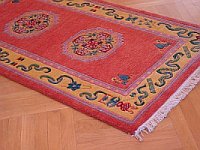 In January of 2008, the owner of artelino GmbH started a project in Kathmandu, Nepal, together with an old friend of his to offer traditional, high-quality Tibetan carpets.
In January of 2008, the owner of artelino GmbH started a project in Kathmandu, Nepal, together with an old friend of his to offer traditional, high-quality Tibetan carpets.
Tibetan Rugs from Nepal
This article describes some basics of the old art of making Tibetan carpets and how the artelino rugs are made. We are committed to provide you with a beautiful top quality product. But we also feel obliged towards the workers for ethically acceptable working conditions. We try to combine business and fair trade and hope it will work.
Traditional Tibetan Carpets
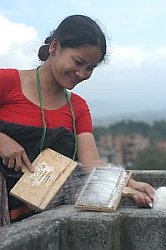 Carpet making has a long tradition in Tibet. The way rugs have been made and used is very different from any other carpet producing regions in this world like for instance Iran, Afghanistan or Turkey.
Carpet making has a long tradition in Tibet. The way rugs have been made and used is very different from any other carpet producing regions in this world like for instance Iran, Afghanistan or Turkey.
The Tibetans use a different knotting technique, called the Senna Loop which is nowhere else to be found.
How Tibetan Carpets were Used
Also the use of carpets is different. Tibetans, unlike Europeans or Americans, do not use them as a floor decoration. The Tibetans use rugs for sleeping or sitting on them. As many of the Tibetans were (and some still are) nomads, it was convenient to have one's bed rolled and strapped behind the saddle. Therefore at least 80% of all Tibetan carpets produced before 1959 - the year of the occupation of Tibet by the Chinese and the escape of the Dalai Lama - have the typical size of ca. 90 by 170/180 cm = ca. 6 by 3 feet.
Carpets in Monasteries
 An important use of Tibetan carpets was in Buddhist monasteries. Before the Chinese occupation an estimated 20% of the male population lived in monasteries as monks and priests - also a result of the Tibetan practice of polygamy. The Tibetan monasteries were important economic and cultural centers.
An important use of Tibetan carpets was in Buddhist monasteries. Before the Chinese occupation an estimated 20% of the male population lived in monasteries as monks and priests - also a result of the Tibetan practice of polygamy. The Tibetan monasteries were important economic and cultural centers.
In the monasteries one could find the so-called temple aisle runners, long, long runners with sections of ca. 90 by 90 cm for the monks to sit during the group prayers and meetings. Apart from the long runners, one could find also the small sitting carpets of ca. 90 by 90 cm. Today the well-to-do Tibetans and Nepalese who can afford a car, use these as seat cushions in their vehicles or on stools and sofas at home.
Finally in some parts of Tibet, mainly in the East, they used rugs as pillar coverings, wrapped around the pillars of assembly and large entrance rooms in monasteries. This habit seems to have its origins in China. The designs of these carpets were often influenced by Chinese roots. The difference between old Chinese and old Tibetan carpet designs is not too big anyway.
Saddle Carpets
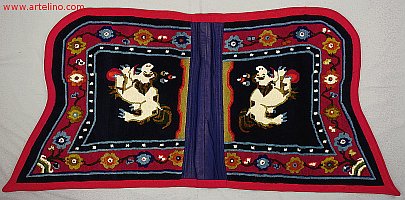
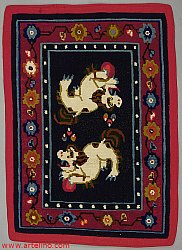
A special Tibetan curiosity are saddle carpets. This is a set of two pieces. One piece is kept between the saddle and the horse, and another one between the saddle and the rider. Thus both the horse and the rider could feel comfortable. Tibetans by the way care usually well for their horses, pets and their live stock.
Saddle carpets often have a red felt or a strong cloth border like the one depicted on this page. Often they have on the backside a wool cloth that may have some thick extra layers inside between the carpet and the cloth backing.
Door and Window Carpets
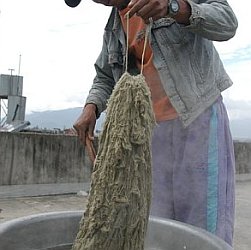 Another strange use was to hang carpets in doors or windows, mainly as a protection against the rough climate. These carpets are different in their designs. The designs show a window or door pattern.
Another strange use was to hang carpets in doors or windows, mainly as a protection against the rough climate. These carpets are different in their designs. The designs show a window or door pattern.
Large Carpets
Large carpets as used in Western countries, are seldom to be found. One could see them only in houses of the nobility and of high-ranking lamas. If you see an old carpet in a size larger than 90 by 180 cm, it was most probably made for export, for instance to India. Tibetan carpets were made for export purposes since roughly the 1930s, but only in limited numbers.
Tibetan Carpets in Nepal
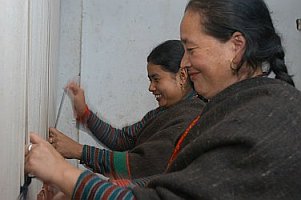 After the flight of the Dalai Lama and ten thousands of Tibetans to Nepal and India, the art of Tibetan carpet making came into their new homelands. Often it was the only way for Tibetans to make a living.
After the flight of the Dalai Lama and ten thousands of Tibetans to Nepal and India, the art of Tibetan carpet making came into their new homelands. Often it was the only way for Tibetans to make a living.
In the 1960s tourism started in Nepal, first the mountaineers, then the hippies and then the package tourists in large numbers. Carpet making took an enormous upswing in Nepal. The carpet industry even became the number one exporter for Nepal. Tourism was in second place.
Tibetans and Nepalese are hard-working and smart people and have a great ability to accommodate Western demands. The Western demand had a striking influence on the sizes, colors and patterns of Tibetan carpets. Westerners wanted large carpets with nothing more than a scarce border pattern and soft colors instead of the brilliantly colored patterns of old Tibetan rugs. Germany soon developed into the major market for Tibetan carpets imported from Nepal.
And thus the traditional Tibetan carpet was soon gone. This happened in the early 1980s at record speed.
What followed was first a huge increase in production in terms of square meters exported. But it had become a faceless product. The thousands of square meters exported had little to do with this unique Tibetan handicraft and art product (yes - this once was ART).
Finally the last ten years or so saw a decrease with the beginning of a military insurgence by an outer-left Communist group that wanted to establish a new order in Nepal after the theories of Mao Zedong. The civil-war like conditions with ca. 12,000 casualties mostly among the Nepalese civilians brought tourism to a near standstill.
Today the Nepalese-Tibetan carpet manufacturing still exists. But in my view it is disoriented, and it has little to do with the old Tibetan carpet tradition except for the use of the materials, the tools and the handicraft skills that are still available.
The artelino Project
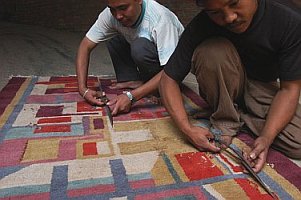 In January of 2008 I came back to Kathmandu after 25 years. I met an old friend of mine whom I have known for nearly 30 years. He owns a carpet manufactory and has been active in the carpet business for decades. In short, we decided to set up a project to revitalize the old tradition of Tibetan carpets, commissioned exclusively by and for artelino.
In January of 2008 I came back to Kathmandu after 25 years. I met an old friend of mine whom I have known for nearly 30 years. He owns a carpet manufactory and has been active in the carpet business for decades. In short, we decided to set up a project to revitalize the old tradition of Tibetan carpets, commissioned exclusively by and for artelino.
Only the Best for artelino Clients
My friend and I discussed the details like what kind of wool to use, which knotting density and more. I wanted to have nothing but the very best for artelino - of course. And thus I had nearly made a few stupid mistakes. But let me explain. There are a few options on which you have to make a decision when it comes to commission a traditional Tibetan carpet.
The Wool
 The best wool comes from Tibet and from New Zealand. That was an easy decision. artelino will be made out of the best wool - either Tibetan or New Zealand or a mix of both.
The best wool comes from Tibet and from New Zealand. That was an easy decision. artelino will be made out of the best wool - either Tibetan or New Zealand or a mix of both.
The Dyes
Tibetans have used aniline colors since the beginning of the 20th century. The synthetically produced dyes provide a means of richer and more intense colors. Before, only vegetable colors obtained from plants and minerals were known. The degree of colorful brilliance is limited when using vegetable colors. Also the variety of colors is limited compared to aniline dyes.
Today at least 95% of the Tibetan carpets are aniline dyed. But vegetable dyes are still available. In my view, none of the two dyes is superior. They are just different. Both are in my personal experience of 30 years living with Tibetan carpets not subject to fading.
Collectors of Japanese prints are only too familiar with the difference between natural colors (until about 1860) and aniline colors. Old woodblock prints from 1800 are very often completely faded, whereas old Japanese prints from the Meiji period (1868-1912) made of aniline colors do not show any traces of fading. As said above, I cannot confirm this for naturally dyed Tibetan carpets based on 30 years of experience.
Designs
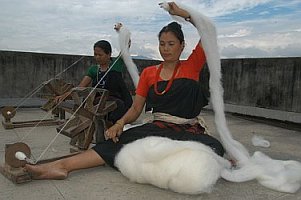 The designs of traditional Tibetan carpets are full of symbols that are mostly related to Buddhism. All symbols are of propitious character like the dragon, snow lion, lotus flower, the Buddhist knot or the phoenix.
The designs of traditional Tibetan carpets are full of symbols that are mostly related to Buddhism. All symbols are of propitious character like the dragon, snow lion, lotus flower, the Buddhist knot or the phoenix.
By and by, artelino will come out with informative articles that will introduce this rich universe of symbols and deities that Himalayan arts and handicraft are so much focused on.
Hand-knotted
All carpets made in Nepal are hand-knotted. That is not an option. But there are roughly three knotting densities:
- 60 knots per square inch
- 80 knots per square inch
- 100 knots per square inch
One would normally think something like "the more knots the better". This is wrong. For the 100 knots technique a thinner thread must be used. Therefore the carpet comes out rather thin and contouring cannot be applied or does not come out nicely.
There is nothing more beautiful like a thick Tibetan carpet with rich patterns and the final contouring of these patterns. In my view the contouring is like bringing the final carpet to life. I have always lived with Tibetan carpets since the 1970s and I have appreciated these robust rugs that do not even lose their beauty and charm after decades.
To wrap it up, we decided to use the 80 knots per square inch technique as the option that produces the most beautiful and most practical carpet in terms of longevity.
Finally a choice had to be made whether to have the wool hand-spun or spun by mechanical tools. The hand-spun wool comes still cheaper, but is more coarse. The final product misses the smooth feeling when you tenderly move your fingers over the surface of the carpet. Therefore we decided on mechanically spun wool. In my one-sided, purist mind it took me a while to accept this decision. But when I compared two carpets, one hand-spun and the other mechanically-spun, I was convinced.
Fair Trade
 My Nepalese friend has traveled to Western countries for attending fairs and visiting his international customers for decades. Germany is the country that he knows best, and where he experienced among others German social structures and working conditions.
My Nepalese friend has traveled to Western countries for attending fairs and visiting his international customers for decades. Germany is the country that he knows best, and where he experienced among others German social structures and working conditions.
This made him establish a children nursery and later a school for the children of the workers. These exist now for decades and are for Nepal exemplary and unique. Currently the carpet manufactory employs three teachers. The costs for the children nursery and the school have to be covered by the income from the carpet sales - something not always easy. Large Western importing companies push for the lowest per square meter prices and could care less about working conditions.
The artelino carpet commissions will support these social activities by paying a fair price. A few dollars can have a big effect in Nepal.
Needless to say that there is no children labor used in the carpet manufactory of my Nepalese friend.
Purchase of Traditional Tibetan Carpets

I want to encourage you to purchase one of these traditional Tibetan carpets. Not for charity reasons (I believe only in projects that are viable for commercial reasons!). But for your own advantage. This is a great, beautiful product that you will not find so easily anywhere else. If you consider that one person works roughly for three months on a carpet of ca. 90 by 180 cm = 3 by 6 feet, the price is definitely more than reasonable. If Nepal should ever make an economic upswing as can be watched currently in China, such prices will be a thing of the past one day anyway. Honestly, I hope it for the people of Nepal. This country holds the position of 13th poorest state in the world.
Carpet Gallery
And here are a few nice pieces in sizes of ca. 90 by 180 cm = 3 by 6 feet. You find similar designs in our online shop of traditional Tibetan rugs.
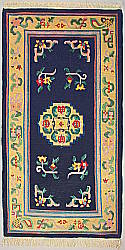
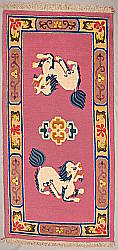
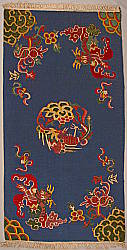
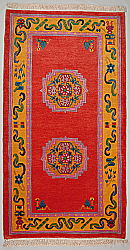
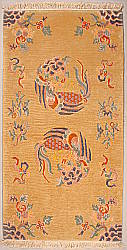
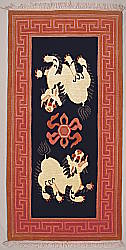
Dieter Wanczura in February of 2008, updated March 2010 (owner of artelino GmbH)







